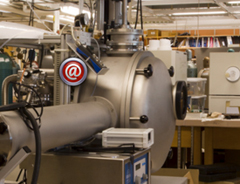Published: November 2011
In the summer of 1999, Zhifeng Ren joined Boston College as a materials scientist in the physics department. He was known for his development of high temperature superconductors and aligned arrays of carbon nanotubes—so small as to be virtually invisible—with potential applications in flat panel displays, solar cells, semiconductors, and biosensors. Ren, whom Science Watch recently ranked among the top 50 materials scientists of the past decade, set about reconfiguring a 2,000-square-foot Higgins Hall space into a facility for superheating, bombarding, compressing, and otherwise manipulating various materials at nanoscale. He went for an open plan instead of an assemblage of small hives, he says, because he prefers to have all the machinery and researchers together. “There is no place to fall asleep,” he jokes.
@BC recently captured panoramic views of Ren’s laboratory (three shots were needed for the long and busy rectangular space), together with close-ups of 10 key devices used by Ren and his 18 graduate students and post-doctoral assistants. To learn more about this equipment, click on the red @ that appears on the screen.

